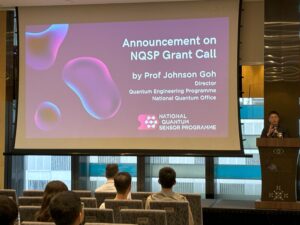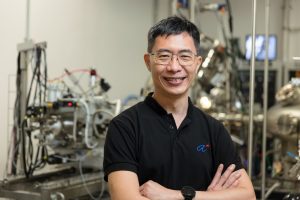
Launching the National Quantum Sensor Programme (NQSP) Grant Call
NATIONAL QUANTUM SENSOR PROGRAMME GRANT CALL 2024 The National Quantum
Singapore’s Quantum Engineering Programme (QEP) aims to realise the benefits of quantum technologies for society. Launched in 2018, it supports translational research focused on industry challenges and initiatives to nurture a quantum ecosystem. Coordinated nationally across various research organisations, it is supported by the National Research Foundation, Singapore and the Agency for Science, Technology and Research, Singapore and hosted by the National University of Singapore.
In this film, meet six people helping to build a quantum future for Singapore. QEP has commissioned this short video to show the breadth and depth of R&D in quantum technologies in Singapore.
Developing routable optically transparent networks, interfaces between photonic and stationary qubits, devices and protocols for the quantum internet, and a national quantum-safe network.
Building quantum processors, devices and hardware that streamline quantum processing platforms, development and application of quantum algorithms for chemistry, materials, supply chain management, finance, and trading,
Detecting and measuring radiofrequency fields, magnetic fields, and gravity in the environment. Also includes development of quantum sensors for satellite-free inertial navigation and for health and life sciences.

NATIONAL QUANTUM SENSOR PROGRAMME GRANT CALL 2024 The National Quantum

On 14 August 2024, QEP hosted a workshop in conjunction

Professor Johnson Goh is the Division Director for the Quantum

Quantum Joint Innovation Accelerator
Keysight Technologies is a supplier of modular and scalable quantum control systems. The Quantum Joint Innovation Accelerator, established under an MOU signed between QEP and Keysight in April 2022, makes it easy for researchers participating in QEP to access several of Keysight’s software design tools and advanced test and measurement equipment. Researchers can apply to evaluate Keysight measurement tools in their laboratories and access equipment hosted at Keysight’s premises in Singapore. Training is also available. Please write to Keysight directly with details of your request.

The Quantum Young Researchers Association (QYRA) aims to bring together the local community of young researchers working in quantum science, with the goal of working towards a vivid quantum ecosystem. The association welcomes all young researchers, including PhD, masters, and final-year-project undergraduate students, postdoctoral fellows, and research assistants.
Project description
Lead PI: Name
Co-PI: Name

Lead PI: Manas Mukherjee, NUS
Co-Pi: Li Hongyu, IME A*STAR
Lead PI: Dimitris Angelakis, NUS
Co-PIs: Adrian Mak, IHPC , A*STAR; Daniel Leykam, CQT, NUS; Paul Griffin, SMU
Lead PI: Rainer Dumke, NUS
Co-PIs: Do Anh Tuan, IME, A*STAR; Chui King Jien, IME, A*STAR; M Kumarasamy Raja, IME, A*STAR
To increase the resolution of fluorescence imaging techniques beyond presumed limits.
To build capability to design, fabricate and characterise chips related to quantum technology, including for qubits.
To pursue miniaturisation of components for atomic clocks.
To develop a long-lived quantum memory based on cold atoms inside hollow-core fibres.
To improve technology for single-photon detection.
To implement a measurement-device independent protocol with chip-based components.
To improve technology for single-photon detection.
This project has a specific objective to develop an integrated low-noise multi-channel active quenching chip to control the discrete GM-APD for high-speed SPC. The proposed circuitry aims to increase the SPC maximum counting speed substantially by reducing the system dead time with unique hardware approaches from both circuit design and device packaging perspectives. This solution is highly scalable and programmable, it provides the flexibility to be configured for different applications and integration with different types of GM-APD devices. This project aims to provide an essential building block for the advanced quantum instrument platform. It will become an enabling technology for many novel high-speed compact quantum systems, which can be adopted by the local and global quantum research community to explore various applications deployed in space or other portable scenarios.
Lead PI: Edwin Hang Tong Teo, NTU
Co-PI: Gao Weibo, NTU
Single-photon counting (SPC) is a cornerstone technology for many quantum engineering applications like quantum cryptography, quantum information processing and quantum imaging, where the detection of single-photon with high temporal resolution is required. Geiger-mode avalanche photodiode (GM-APD) or called single-photon avalanche diode (SPAD) is widely recognized as the best candidate for single-photon detector because of its outstanding performance at room temperature, miniaturized size and low fabrication cost. After a photon is detected, the GM-APD device need to be quenched and reset to the initial condition. Therefore, minimizing the dead time of single-photon detector is the key approach to build a high-speed SPC module.
Lead PI: Gao Yuan, IME, A*STAR
Co-PIs: Alexander Ling, NUS; Do Anh Tuan, IME, A*STAR; Zhang Tan-tan, IME, A*STAR
Integrated photonics are a promising route towards scalable quantum photonics technologies. Integrated photodetectors will be an essential component of such platforms. Avalanche photodetectors (APDs) are an important alternative to superconducting photodetectors as they do not require cryogenic environments. This project aims to develop integrated APDs for visible light, which will enable quantum information and sensing applications based on quantum emitters operating at visible wavelengths, such as trapped ions, colour centers in diamond, quantum dots, 2D materials, etc. Such devices will also greatly benefit application areas such as visible-light communications and low-light imaging.
Lead PI: Victor Leong, IMRE, A*STAR
Co-PIs: Thomas Ang, IHPC, A*STAR; Alexander Ling, NUS
The main research target of this proposal is to leverage room temperature quantum sensors, based on NV centers in diamond, for detecting protein-based biomarkers for cancer and viral infection, and Nanoscale NV center magnetic resonance imaging for disease diagnosis. The proposed research lies at the intersection of topics in quantum sensing, scanning probe microscopy, confocal microscopy and health science. The result of the proposal would facilitate magnetic imaging techniques with high sensitivity for biological and
medical applications.
Lead PI: Gao Weibo, NTU
Co-PIs: Liu Xiaogang, CHE, NUS; Miao Yansong, SBS, NTU
Hyperspectral infrared (IR) microscopy has become an increasingly useful tool for biomedical applications in the last three decades. It allows the spatial mapping of chemical fingerprints which can be correlated with biological states and functions. However, despite the usefulness and strong interest, the field is impeded by the high cost, complexity, and inferior performance of IR optical components. To overcome these challenges, we leverage the phenomenon of “quantum imaging with undetected photons” to retrieve IR images from the detection of correlated photons at the visible range.
Our project aims demonstrating a practical quantum hyperspectral IR microscope built out of optical components operating in the visible. The microscope will be able to capture the lipid content in tissue samples from IR fingerprints. This will enable differentiation between “young” and “aged” tissues, potentially laying the foundation for novel biomarkers and personalised medicine approaches. As a result, this programme will bring quantum IR imaging into practical realization and widespread adoption based on its low-cost, versatility and multi-functionality of the system.
Lead PI: Anna Paterova, IMRE, A*STAR
Co-PI: Gianluca Grenci, MBI, NUS
This project aims to develop inertial sensors that are based on measurements of the quantum states of ultracold atoms, a magnetic sensor relying on NV-centres in diamond, and low-noise, high-stability lasers that can be integrated into these devices. Interest in inertial sensors is driven by applications in navigation: precise measurement of acceleration and rotation could support navigation in areas where the Global Positioning System (GPS) is unavailable or unreliable. The team aims to beat the performance of today’s military-grade systems, which are showing errors of ~100m per hour, which is 1-2 orders of magnitude larger than GPS. Magnetic sensing is useful for environmental monitoring, and this project will explore the technology’s ability to detect moving objects.
Lead PI: Rainer Dumke Nanyang Technological University
Co-PIs: Christoph Hufnagel, CQT, NUS; David Wilkowski, NTU; Ben Olsen, Yale-NUS; Lan Shau-Yu, NTU; Gao Weibo, NTU; Wong Chee Wei, NUS; Alexander Ling, NUS
Plasmonic nanopores present a promising approach for achieving rapid and accurate DNA sequencing. In this project, we propose a lateral bowtie-in-slot nanoplasmonic configuration for high-precision DNA sequencing and dynamic switching by tuning the operational states of the incident laser. When the laser is ON, a plasmonic hot spot is generated at the gap region of the bowtie; the optical force within the hot spot immobilizes the DNA molecules, generating stable surface-enhanced Raman scattering (SERS) signals. Meanwhile, the presence of DNA molecules induces modifications in the channel impedance, leading to alterations in the ion current of the system. Conversely, when the laser switches OFF, the optical forces diminish due to the absence of the plasmonic hot spot, allowing the DNA molecules to regain mobility. Sequential DNA molecule sequence information can thus be obtained by modulating the laser’s operational states. At the back end of the plasmonic nanopore, we will also explore the integration of AI algorithms that may enable rapid and accurate reconstruction of DNA sequences. Compared with conventional nanopores, our design facilitates simultaneous electro-optical DNA sensing through dynamic switching, significantly enhancing sequencing accuracy and reducing processing time. Moving forward, our plasmonic nanopore configuration provides an on-chip detection platform, holding great promise for enabling massively parallel DNA sequencing.
Lead PI: Wu Lin, SUTD
Co-PIs: Dong Zhaogang, IMRE, A*STAR; Qiu Cheng-Wei, ECE, NUS; Gao Weibo, NTU
We propose to develop a method and device for optical range finding without introducing timing modulation in the light source, by exploiting the timing correlations in thermal light.
The problem to address is how to perform a ranging measurement using stationary light. This avoids a time modulation of the ranging light source, which may allow it to be detected by a third-party and be susceptible to optical crosstalk, be it accidentally introduced e.g., by other lidar modules nearby in a growing fleet of autonomous vehicles, or intentionally so by a malicious third-party.
Lead PI: Tan Peng Kian, NUS
Co-PI: Christian Kurtsiefer, NUS
This project aims to make use of deployed optical fibers and explore their usage for seismic sensing purposes. For this, a hopefully shot-noise limited heterodyne interferometer is developed, that can sense the phase change of light passing through a probe fiber with respect to a local reference. As the length change of a deployed optical fiber is associated with a phase change of this signal, and phase changes with a reasonably high accuracy can be established that should ultimately be limited by the quantum fluctuations in the light field received, very small length changes due to strain caused by seismic events should be detectable. Such a sensor can run on an optical fiber outside the normal Internet traffic, and thereby should not be a heavy load on resources. Given the vast amount of fiber deployed in a metropolitan area, such fiber sensors could form an array of seismometers with relatively little hardware effort. The goals of this project are to determine the sensitivity of an interferometric length change, look for a correlation between a seismic event registered by conventional detectors, and assess the opportunities for deploying a distributed fiber sensing network.
Lead PI: Christian Kurtsiefer, NUS
Ultra-sensitive magnetometers can be used in diverse applications ranging from brain/heart imaging to mineral and geomagnetic surveys. By using ultra-sensitive magnetometers, it is also possible to envision performing nuclear magnetic resonance (NMR) or magnetic resonance imaging (MRI) without using large and expensive magnets, which can significantly decrease the cost of NMR and MRI machines while increasing their portability. Such magnetometers can also be used to probe the nuclear quadrupole resonance (NQR) of various chemicals, which can be useful for pharmaceutical control applications, as well as in explosives or narcotics detection.
In this project, we are developing alkali atomic scalar magnetometers as the next-generation of ultra-sensitive magnetometers that are capable of reaching fT/sqrt(Hz) sensitivities without needing the cryogenic cooling that current state-of-the-art Superconducting Quantum Interference Devices (SQUIDs) require. This translates to significant cost-savings and flexibility in operation, which can not only enhance many of the applications listed above, but also unlock heretofore unexplored applications.
Lead PI: Lee Junyi, IMRE, A*STAR
In pursuit of achieving net-zero emissions by 2050, Singapore is exploring the immense potential of geothermal energy as a promising renewable solution. Despite limited knowledge about its geothermal resources, a groundbreaking project led by renowned scientists, Professors Rainer and Wei from NTU, aims to bridge this gap by conducting an extensive investigation.
The project’s focal point is Sembawang, where advanced gravimeter sensors are utilized to measure gravity anomalies caused by subsurface fluids. Professor Rainer and his team have developed a cutting-edge quantum gravimeter capable of precise absolute gravity measurements. Simultaneously, Professor Wei and his team have deployed relative gravimeter stations at the Sembawang drilling site to obtain relative gravity values. By calibrating the relative gravimeter readings with absolute gravimeter data, the teams can generate a detailed map of absolute gravity anomalies across the test site.
Additionally, seismic sensors are being deployed by Professor Wei and his team to detect potential seismic signals originating from active faults beneath the subsurface. The integration of gravity and seismic surveys within this project promises crucial insights into subsurface geothermal energy, significantly contributing to future geothermal exploration in Singapore. Leveraging these innovative approaches, the project aims to pave the way for a sustainable and greener future, aligning with Singapore’s net-zero emissions target by 2050.
Lead PI: Rainer Dumke, NTU
Co-PIs: Benoit Taisne, NTU; Wei Shengji, NTU; Christoph Hufnagel, CQT, NUS
The aim of quantum annealing is to solve optimization problems efficiently through a physical system which naturally evolves towards the ground state of a spin-Hamiltonian. A prerequisite of such a system is programmability of long-range qubit interactions (preferably each qubit should have a programmable interaction strength with every other qubit). Along with programmable qubit interaction strengths, an annealer must efficiently reach the ground state in a reasonable amount of time to complete a given computation. In this project, our objective is to implement a photonics-based annealer which naturally solves a relevant spin-Hamiltonian, operates at room temperature, and critically, achieves all-to-all programmable coupling of qubits with favorable scaling of system complexity with qubit count.
Lead PI: Aaron Danner, NUS
Co-PIs: Dr Lim Soon Thor, IHPC, A*STAR
Trapped atomic ions are one of the leading platforms for implementation of quantum processors. It offers long coherence time, high gate fidelity, and good connectivity. In this project we are working on building a prototype of a small trapped ion quantum processor that allows us to explore two different models of quantum computing: traditional discrete variable computation model where all the information is encoded into the states of two level systems, qubits and the interaction between these qubits is enabled through the common modes of motion, as well as hybrid approach to quantum computations where information is stored and processed as the states of the harmonic oscillators, and interaction between these oscillators is induced via the spin-motional coupling.
Lead PI: Dzmitry Matsukevich, NUS
The main purpose of the project is to investigate potential improvements in estimating the accuracy of the probability of an occurrence of a rare event in a specified time frame using quantum stochastic modelling in financial markets in collaboration with UOB. Rare events in financial time series can be seen as sporadic and drastic jumps in financial assets returns. A quantum stochastic simulation approach will be used to compute rare-event stochastic likelihoods, with greater speed and accuracy relative to the underlying structure of the parameters and dynamics accessible by sampling the conditional future of a complex process in quantum superposition. Furthermore, quantum models of complex processes can exhibit enhanced dimensional reduction resulting in less distortions from dimensional reduction of raw data. When coupled with quantum amplitude amplification and estimation algorithms, we can potentially get a better estimate of the probability of rare events while running fewer stochastic samples, as well as biasing sampling towards rare events to better understand their effects, and better isolate early signatures of such events. We will also consider the practicality of implementing such models for regulators and banks.
Lead PI: Gu Mile, NTU
Co-PIs: Paul Griffin, SMU; Vlatko Vedral, CQT, NUS; Ariel Neufeld, SPMS, NTU; Rajesh Balan, SMU
Quantum computing offers exponential acceleration potential compared to classical computing, making it of extraordinary significance in computational mechanics. This project focuses on harness the potential quantum speed advantage by transferring extensive computational tasks from classical computers to quantum computers. The objective is to accelerate computation with quantum computing, enabling the successful implementation of engineering optimization designs that are challenging for classical computers. To illustrate this methodology, we showcase an auxetic mechanoluminescence materials and develop a quantum computing-based optimization design platform. We will utilize quantum computing to perform topological optimization, through searching for the global optimum that maximizes the luminescent performance from an extensive range of possible topological structures. The platform developed in this project will be versatile and capable of extending to various application scenarios, providing effective and efficient methods for broad optimization design in engineering mechanics.
Lead PI: Lu Dingjie, IHPC, A*STAR
Co-PIs: Tan Yu Jun, ME, NUS; Liu Zhuangjian, IHPC, A*STAR; Liu Jun, IHPC, A*STAR
The project addresses the topic of quantum computing in finance through the lens of computer science. In particular, we address the challenges of the pricing of financial options and the optimization of portfolios. We pursue the design and development of quantum algorithms for these problems, focusing on possibilities, limitations, and progress towards realistic implementations. The algorithms are developed with input from domain experts and investment professionals.
Main projects:
i) Pricing of American and other options with quantum-accelerated Monte-Carlo methods.
ii) Partial differential equations for nonlinear Black–Scholes equations (e.g., with default risk) with quantum algorithms and deep learning.
iii) Aspects of quantum random access memory implementations such as the unbounded fan-out gate and global entangling gates.
iv) Sparse portfolio selection with quantum-accelerated (constrained) Lasso.
v) Compilation, circuit optimization, and benchmarking of common financial quantum subroutines.
vi) Quantum recommendation systems and online learning.
Lead PI: Patrick Rebentrost, NUS
Co-PIs: Miklos Santha, CQT, NUS; Chen Ying, Mathematics, NUS; Dai Min, Mathematics, NUS; Pun Chi Seng, SPMS, NTU; Antonios Varvitsiotis, SUTD; Marco Tomamichel, CQT, NUS; Rahul Jain, CQT, NUS; Hartmut Klauck, CQT, NUS; Anupam Chattopadhyay, SCSE, NTU
We aim to advance spin-based qubits as a basic quantum computing resource through materials engineering in semiconductors. One leading platform is based on precision placed donors in silicon which is a mature technological material with many well-established processes for wafer level fabrication. Single- and two-qubit gates built on the silicon platfrom have been demonstrated with high fidelities by a few international groups in the last decade. The goal of this project is to establish the critical technology of precision donor placement in Singapore for (1) anchoring essential fabrication R&D in Singapore, (2) realising demonstration spin-qubits in silicon, (3) providing a local base for international collaboration in spin-qubits.
The first phase of 3 years is to build the infrastructure for precision donor-placement, develop the device fabrication and characterisation capabilities in Singapore, and train the local manpower. We collaborate with experts on materials modelling, quantum device design and quantum error correction algorithms to inform our developments.
Lead PI: Kuan Eng Johnson Goh, IMRE, A*STAR
Co-PIs: Bent Weber, SPMS, NTU; Koh Teck Seng, SPMS, NTU
Cavity QED setups are composed of one or a few atoms which interact with light focused by two mirrors. The interplay between light and atoms can lead to the emergence of different phases of matter and it can also be used for precision measurement devices. Such systems, however, are typically difficult to integrate in micro and nano electronic systems. Here, we aim to push towards the miniaturization and improved performance of cavity QED by (i) improving the classical models and algorithms used to study them, (ii) studying the effect of patterned mirrors, (iii) developing hybrid classical-quantum algorithms to study them or accelerate methods developed to characterize the mirrors. We also consider scenarios with multiple two-level systems in the cavity and we plan to apply the outcomes of these investigations to the use of (micro-)cavity QED as sensors.
Lead PI: Dario Poletti, SUTD
Co-PIs: Wu Lin, SUTD; Kwek Leong Chuan, CQT, NUS; Ricky Ang, SUTD; Koh Enshan, Dax, IHPC, A*STAR; Khoo Jun Yong, IHPC, A*STAR; Wu Chunfeng, SUTD
We aim to realize a scalable and programmable quantum simulator using reconfigurable arrays of ultracold atoms that are individually trapped in optical tweezers. This will be achieved on two fronts: first, we will develop new atom-sorting algorithms that allow us to demonstrate large-scale defect-free atom arrays; second, we will use Floquet techniques to increase the programmability of interactions between atoms in the tweezer array. These research directions will proceed in tandem with theory efforts to uncover interesting non-equilibrium states. The proposed research will be facilitated by close collaboration between researchers in experimental atomic physics, theoretical condensed matter physics, and computer science.
The aim of the project is to demonstrate a successful exchange of quantum information between different physical systems, and explore techniques to match wavelengths and coherence times of participating photons.
Lead PI: Marco Tomamichel, NUS
This project is to address a key challenge facing in the optical clock network, the noise (e.g., phase noise, timing jitter, frequency stability) in the coherent transport of an optical frequency over a long fiber-optic link, which is critical for a successful dissemination of optical frequency (e.g., Lu+ clock in Singapore) at an accuracy level of 10-18 and beyond.
The key objectives of this project are therefore to establish an optical network with local research ecosystem to carry out dedicated experiment:
1. To understand and characterize high-quality delivery of optical atomic clock signals through optical fibres, with the proposal of noise mitigation solutions.
2. To build a rack-mounted laser system for Lu+ clock and provide clock signals for characterizing the optical fiber link to be established.
After the project, a coherent optical-fiber link with noise characterized is expected to support the buildup of an optical clock network in Singapore in terms of reliability and performance (10−17 to 10−18), and the establishment of a key platform for applications in the fields of metrology, fundamental physics, navigation, and spectroscopy using Lu+ optical clock.
The physical systems that form stationary qubits are neutral atoms, color centers in solids, and ions in ion traps, while the flying qubits establishing quantum information exchange should be compatible with the high transparency windows of deployed telecom fiber in the C band or preferably O band.
Lead PI: Gao Weibo, NTU
Co-PI: Alexander Ling, CQT, NUS
This project aims to demonstrate entanglement or quantum information exchange across different physical systems by making use of optical qubits that ideally are compatible with telecom fibers.
Lead PI: Christian Kurtsiefer, NUS
Co-PIs: Gao Weibo, SPMS, NTU; Manas Mukherjee, CQT, NUS; Cesare Soci, SPMS, NTU
This project aims to establish the hardware necessary to implement a dial-up transparent optical network for quantum communication riding on the existing fiber network in Singapore.
The core part of this project is to develop optical multiplexers that can bypass classical Internet routing hardware, and provide a reconfigurable optical routing on a spectral window that is not used for classical traffic. The main challenge was to identify and characterize the switching technology suitable for quantum traffic. A key requirement is that insertion loss should be minimal, and quantum states encoded in single photons need to be preserved. Switching times should be short compared to typical run times of quantum communication sessions, which last on a minute to hour time scale.
The project identifies a few switching technologies, and implements network-compatible devices with a simple software interface, and for different routing topologies.
Lead PI: Christian Kurtsiefer, NUS
With the rise in practical and economically viable quantum computers or quantum information processors, various applications that require the exchange of quantum information between distributed devices are being developed or envisioned. A fundamental requirement for realizing these applications is the development of a network that is capable of generating, distributing, and processing quantum information (in addition to classical data). The objective of this project is to develop network layer solutions for the quantum Internet. While the quantum Internet focuses on the transfer of qubits and quantum entanglement, one of its key requirements is that it will co-exist and share the same physical resources (e.g. optical fibers) as the traditional Internet. This project specifically considers the problems associated with the co-existence of quantum Internet with next-generation data networks that are going to be based on softwarization and virtualization of network functions. The project aims to design and evaluate architectural and protocol level solutions that enable and manage this coexistence.
Lead PI: Biplab Sikdar, NUS
Co-PI: Purnima Murali Mohan, Infocomm Technology, SIT